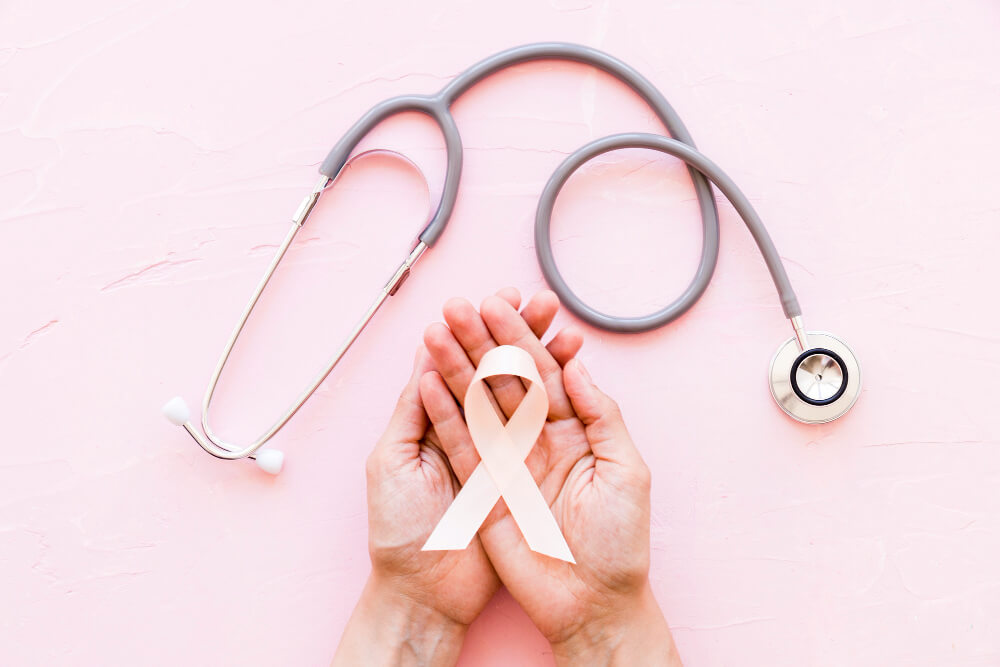Cervical cancer is a type of cancer that starts in the cervix. This is the lower part of the uterus that connects to the vagina. While it can be serious, is often preventable and treatable, especially when detected early.
What causes it?
Most cervical cancers are caused by persistent infection with certain types of Human Papillomavirus (HPV), a common virus spread through sexual contact. However, not everyone exposed to HPV gets cervical cancer, as the body’s immune system usually clears the virus.
Reducing your risk:
- HPV vaccination: Getting vaccinated against HPV can significantly reduce your risk of developing cervical cancer.
- Regular screening: Pap tests and HPV tests can detect precancerous changes in the cervix, allowing for early intervention and treatment before cancer develops.
Treatment options:
Surgery is often the first line of treatment, followed by potentially:
- Chemotherapy: Medications to kill cancer cells.
- Targeted therapy: Drugs that target specific weaknesses in cancer cells.
- Radiation therapy: High-energy beams to destroy cancer cells.
Early Warning Signs: Don’t Ignore These Potential Signs of Cervical Cancer
While cervical cancer often starts silently, it’s crucial to be aware of potential warning signs that might arise as it progresses. Here are some key symptoms to watch for:
Unusual Vaginal Bleeding:
- Bleeding after intercourse, between periods, or after menopause: This is a red flag, especially if it’s new or persistent.
- Heavier and longer menstrual periods: Pay attention to changes in your usual cycle pattern.
Changes in Vaginal Discharge:
- Watery or bloody discharge: This could be a sign of precancerous or cancerous changes.
- Foul-smelling discharge: An unusual odor can be a potential indicator.
Pelvic Pain:
- Discomfort in your lower abdomen or pelvis: This could be a sign of cancer spreading to nearby tissues.
- Pain during sex: This can be caused by cervical changes or inflammation.
From Healthy Cell to Cancer: Understanding Cervical Cancer’s Journey
Imagine the cells in your cervix like tiny workers following a blueprint – their DNA. But sometimes, this blueprint gets corrupted, leading to uncontrolled growth and the potential for cancer. Let’s break down how this happens in cervical cancer:
The Cell’s Rebellion:
- DNA Damage: The journey starts with mutations in the cell’s DNA, the instruction manual. These changes disrupt the normal “life cycle” of cells, causing them to multiply uncontrollably.
- Immortality Gone Wrong: Unlike healthy cells that eventually die, these altered cells refuse to let go, forming a mass called a tumor.
- Invasion and Destruction: The tumor becomes aggressive, invading and damaging surrounding healthy tissues.
- Spreading Far and Wide: In advanced stages, cancerous cells can break free and travel to other parts of the body.
HPV: The Culprit in Most Cases:
The majority of cervical cancers are linked to a common virus called Human Papillomavirus (HPV). While usually harmless and cleared by the body, certain strains of HPV can persist, contributing to the DNA changes that trigger cancer.
The Two Main Faces of Cervical Cancer:
Two major types of cervical cancer are classified based on the cell of origin:
- Squamous Cell Carcinoma: This type starts in the flat, outer cells of the cervix and comprises most cervical cancers.
- Adenocarcinoma: This type originates in the gland cells lining the inner canal of the cervix.
Protect Yourself: Reducing Your Risk of Cervical Cancer
Cervical cancer, while serious, is often preventable. Here’s a breakdown of key risk factors and steps you can take to lower your chances:
Boost Your Defenses:
- HPV Vaccination: This powerful tool protects against the main culprit behind cervical cancer. Consult your doctor to see if you’re eligible.
- Strong Immune System: Prioritize healthy habits like a balanced diet, exercise, and stress management to optimize your body’s natural defenses.
Limit Your Exposure:
- Safe Sex Practices: Using condoms consistently and limiting sexual partners can significantly reduce HPV transmission.
- Early Sexual Activity: Delaying initial sexual contact can lower your risk of exposure to various viruses and infections.
- Other STIs: Seek prompt diagnosis and treatment if you suspect any sexually transmitted infections.
Be Mindful of Other Factors:
- Smoking Cessation: Smoking weakens your immune system, making you more susceptible to HPV-related complications. Quitting significantly reduces your risk.
- Regular Pap Tests: These screenings detect precancerous changes early, allowing for timely intervention and prevention. Follow your doctor’s recommended schedule.
- Family History: If you have a family history of cervical cancer, discuss increased monitoring and preventive measures with your doctor.
FAQs:
- Q: What are the early signs of cervical?
- A: Early stages may be asymptomatic, but as the cancer progresses, symptoms can include abnormal vaginal bleeding, pelvic pain, and unusual vaginal discharge.
- Q: How is diagnosed?
- A: Cervical cancer is often diagnosed through a Pap smear, and if abnormalities are detected, a biopsy may be performed for further evaluation.
- Q: What are the available treatment options for cervical cancer?
- A: Treatment options include surgery, chemotherapy, radiation therapy, and targeted drug therapy, tailored to the individual’s cancer stage and overall health.
- A: Treatment options include surgery, chemotherapy, radiation therapy, and targeted drug therapy, tailored to the individual’s cancer stage and overall health.
- Q: Can cervical cancer be prevented?
- A: Yes, the most effective prevention is vaccination against HPV. Regular Pap smears, safe sex practices, and avoiding smoking also contribute to reducing the risk.
- Q: Where can I seek treatment in Kanpur?
- A: For cervical cancer treatment, consider consulting with the reputable hospital Dhanvantri Healthcare Best hospital in Kanpur, known for its expertise in cancer care.
Reference –
https://www.cancer.net/cancer-types/cervical-cancer/view-all
https://www.clinicalkey.com.
https://www.mayoclinic.org/diseases-conditions/cervical-cancer/symptoms-causes/

